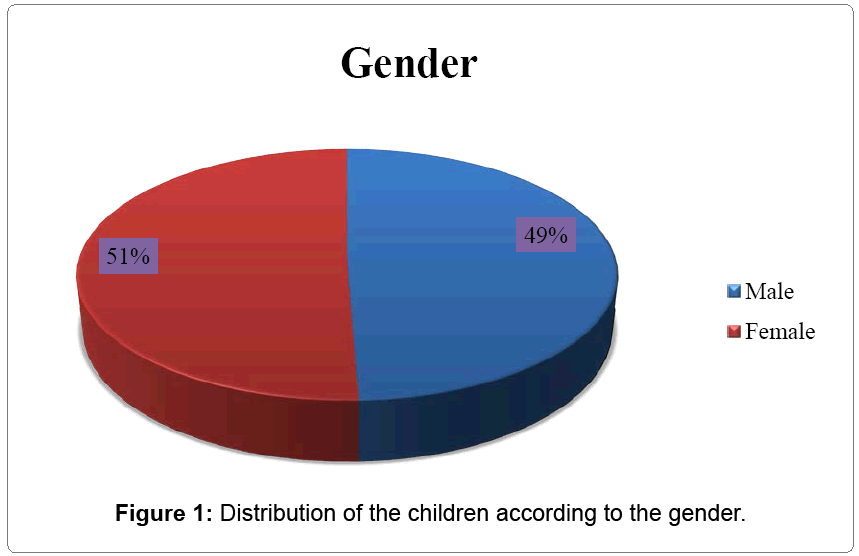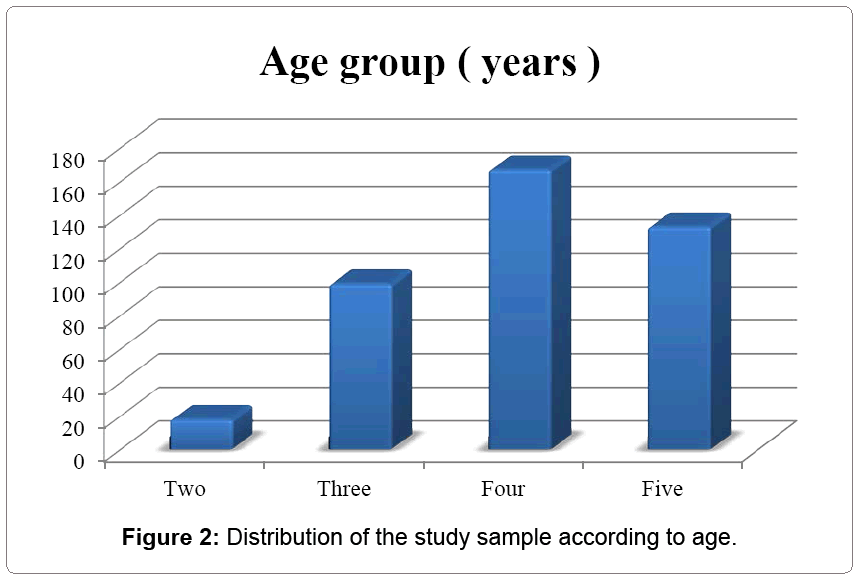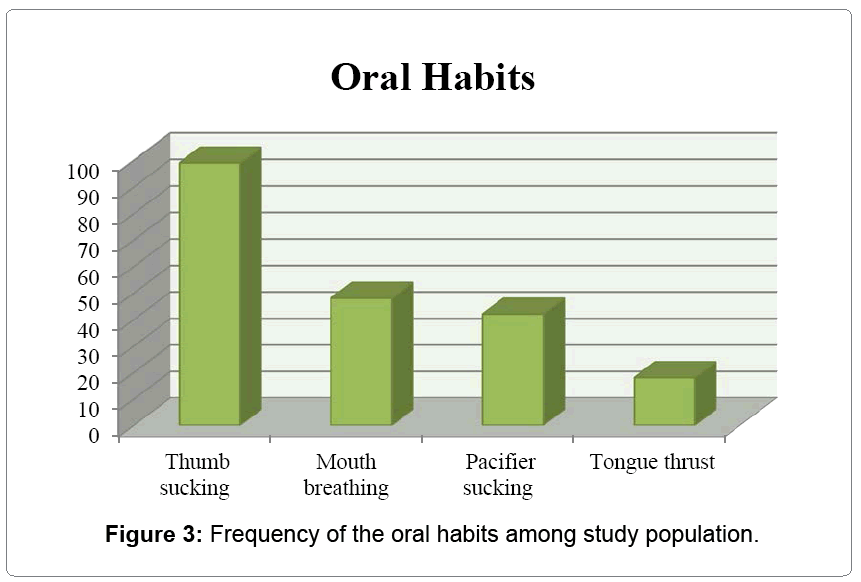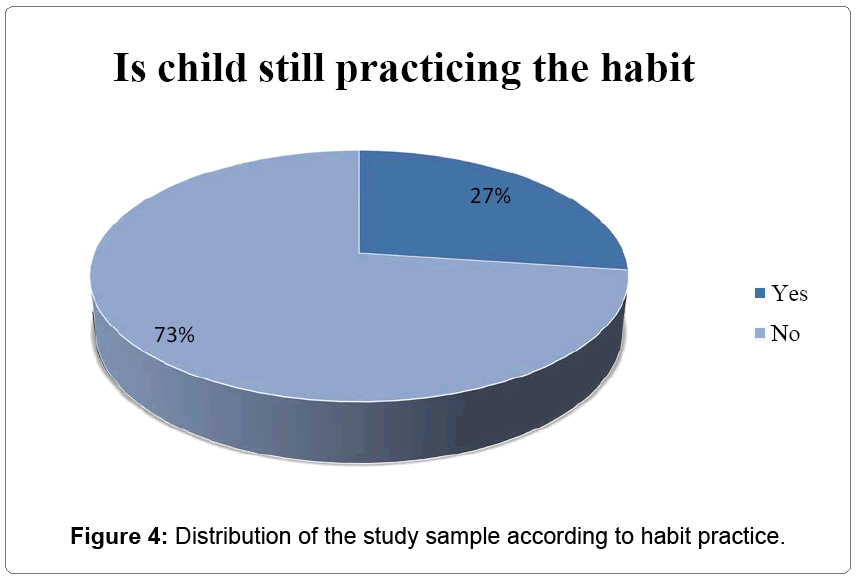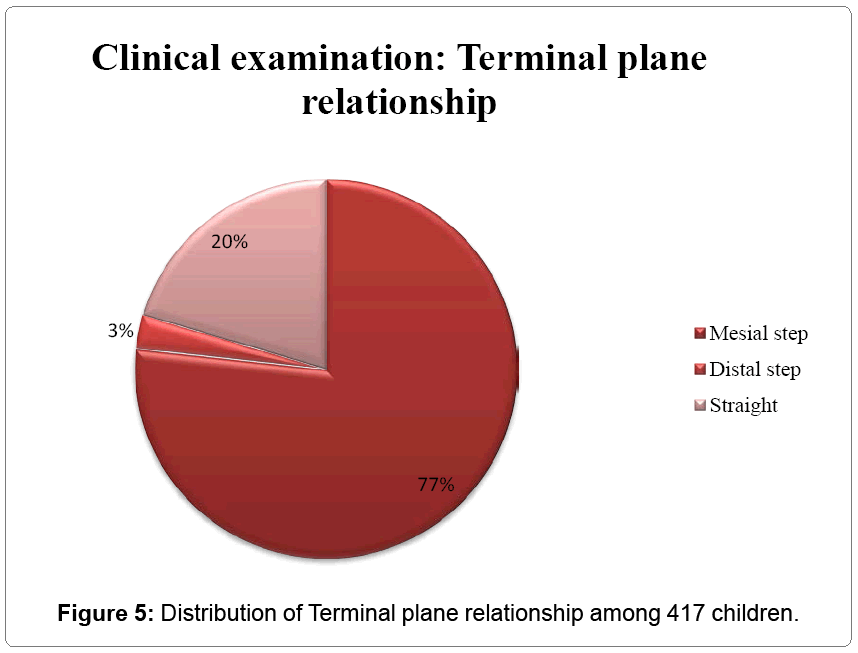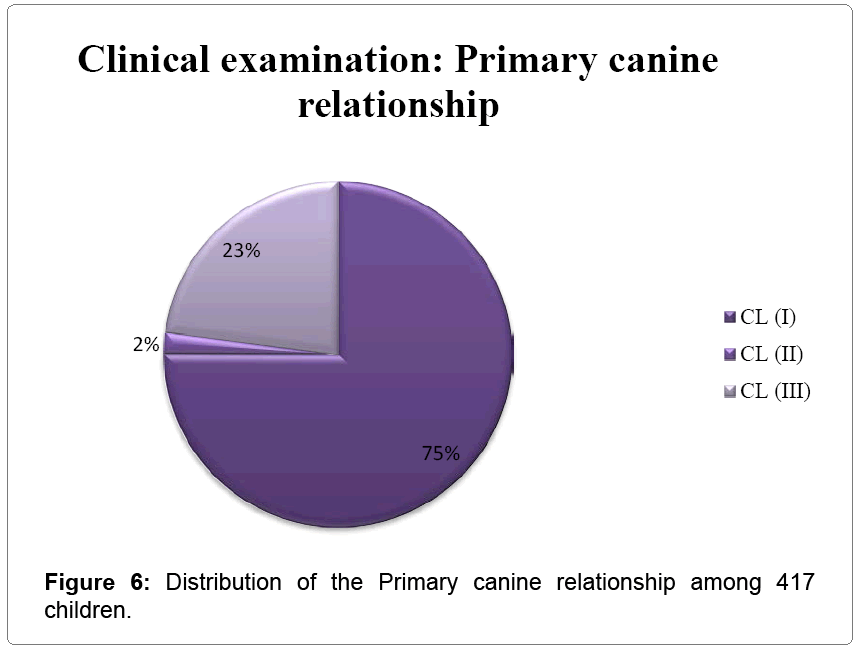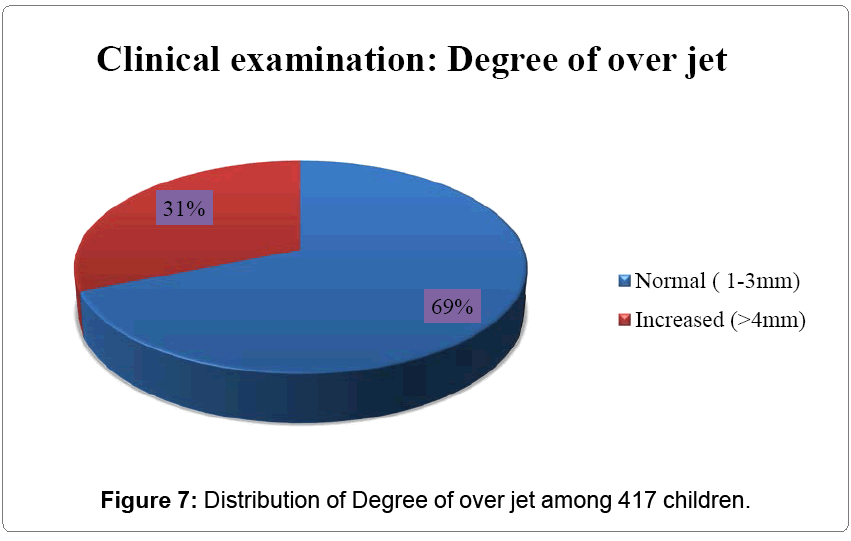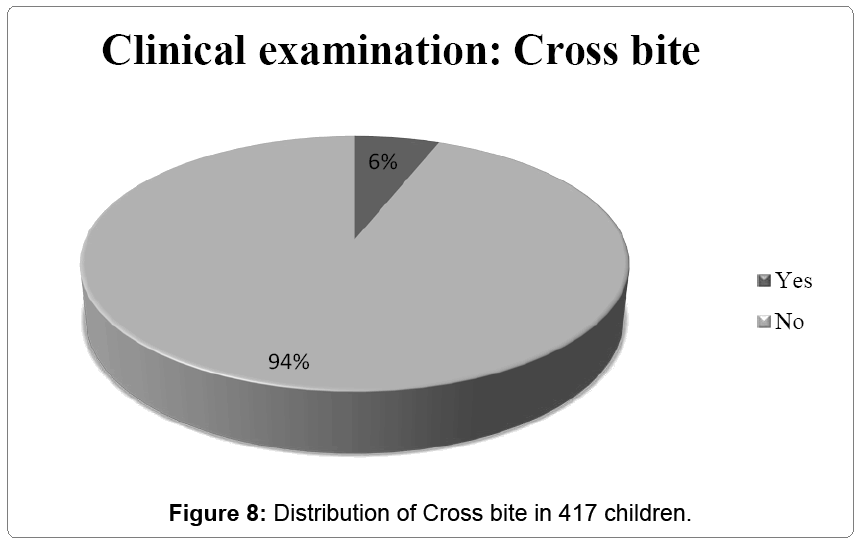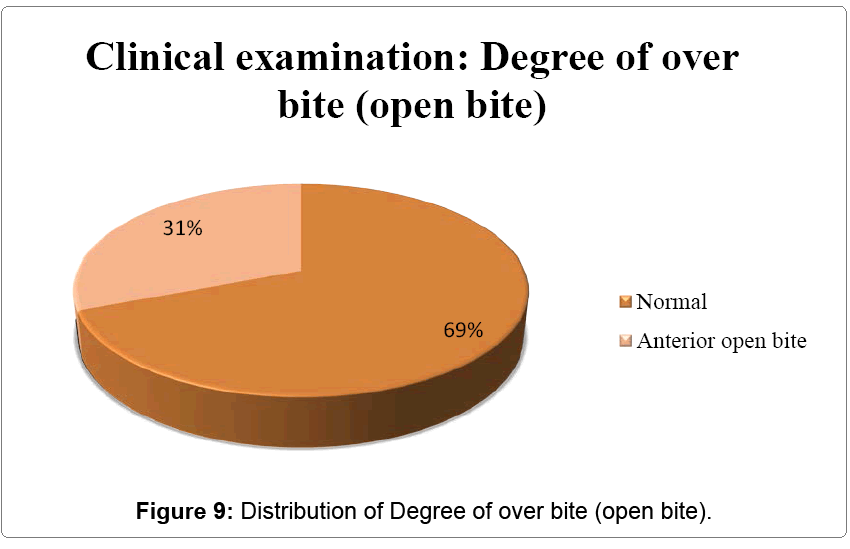Research Article Open Access
Oral Habits and Occlusal characteristic in Preschool Children in Khartoum State
Ahmed FH1 and Abuaffian AH2*1General dentist, University of Medical Sciences and Technology, Khartoum, Sudan
2Department of Orthodontics and Pedodontics, University of Medical Sciences and Technology, Khartoum, Sudan
- *Corresponding Author:
- Abuaffian AH
Associate Professor
Department of Orthodontics and Pedodontics
University of Medical Sciences and Technology
Khartoum, Sudan
Tel: +00249912696035
E-mail: amalabuaffan@yahoo.com
Received date: March 18, 2016; Accepted date: March 23, 2016; Published date: March 30, 2016
Citation:Ahmed FH, Abuaffian AH (2016) Oral Habits and Occlusal characteristic in Preschool Children in Khartoum State. Pediatr Dent Care 1:105. doi:10.4172/pdc.1000105
Copyright: ©2016 Ahmed FH, et al. This is an open-access article distributed under the terms of the Creative Commons Attribution License, which permits unrestricted use, distribution, and reproduction in any medium, provided the original author and source are credited.
Visit for more related articles at Neonatal and Pediatric Medicine
Abstract
Background: Habits are acquired automatisms, represented by an altered pattern of muscle contraction with complex characteristics, which proceed unconsciously and in a regular basis.
Objectives: To determine the prevalence of oral habits in preschool children 2-5 years old and to assess the correlation between habits and malocclusion.
Material and method: A cross-sectional study conducted by questionnaire and clinical examination for 417 preschool children aged 2-5 years using a stratified cluster random sampling technique. Chi-square test in SPSS was used for statistical analysis.
Results: Thumb sucking habit is the most common occurrence of oral habit (23.7%), followed by mouth breathing (11.5%), pacifier sucking (10.1%) and tongue thrust (4.3%). All the habits were more frequent among 4 years of age. Anterior open bite was found to be (31%) and high significant value with thumb sucking and mouth breathing (P-value=0.000). A significant difference was recorded between thumb and pacifier sucking habit and cross bite (P-value=0.00).
Conclusion: Oral habits among a sample of Sudanese preschool children were found to be very frequent 48.9%. Education program should be established for parents and preschool teachers about the sound effects of oral habit on occlusion.
Keywords
Oral habits; Thumb sucking; Mouth breathing; Preschool children
Introduction
Oral habits are acquired automatisms, represented by an altered pattern of muscle contraction with complex characteristics, which proceed unconsciously and in a regular basis. Some habits occur in the oral region and may have harmful effects on health, promoting changes in dental, bone and muscle tissues [1].
The severity of habits determined by intensity, frequency and duration of in appropriate pressure [2]. Oral habits, especially if persist beyond the preschool age; have been implicated as an important environmental etiological factor associated with the development of malocclusion [3-5].
Malocclusion can be defined as an occlusion in which there is abnormal relationship in a vertical, horizontal, or transversal dimension or in which there are abnormal tooth positions beyond the acceptable range of normal limits [6].
Nutritive sucking habits are breast and bottle feeding, whereby the infant obtains food, or through non-nutritive sucking on objects such as digits, pacifiers, or toys that may serve primarily to satisfy psychological needs. These behaviors are normal in infants and young children, prolonged duration of such behaviors may have consequences in regard to the developing oro-facial structures and occlusion [7].
The prevalence of nonnutritive sucking habits among preschool childrenfound in the previous literature17% [8] to 50% [9]. This high percentage is commonly linked with some social factors; family income, parents’ educational level, and difficult access to dental services [10].
Sucking habit is one of the most common reflexes seen in infants. It manifests when they are in intrauterine life around 29 weeks of age. This is the first pattern of behavior observed in infant and may use finger, thumb, pacifiers, or other objects to feel secure and learn the outside world. Sucking habit is commonly seen when the child is anxious, insecure or surrounded by strangers and in families when they are separated from their parents. Sucking habit induces sleep and hence makes infant and child calm and relaxed [11].
The habits are normal up to 2-4 years of age. It becomes a concern when continued for longer time and even seen in mixed dentition phase. This is the first sign for child to manifest future malocclusionor discrepancy during mixed dentition. It has been documented that parental education, child’s nutrition, and sucking habits are associated with each other [12].
The effect of prolonged sucking habit in children may result in anterior open bite, increased over jet, lingual inclination of lower incisor and labial inclination of maxillary anterior, posterior cross-bite, deep palate, compensatory tongue thrust, and sometimes speech defect [13].
Management of oral habits should be directed for correction of the underlying problem. Thumb sucking that persists beyond the age of six years should be treated. Behavioral conditioning techniques, positive reinforcement and dental appliances are important aspects of treatment [14].
Tongue thrust an abnormal tongue position and deviation from the normal swallowing pattern, and mouth breathing may be associated with anterior open bite, abnormal speech, and anterior protrusion of the maxillary incisors [15].
A wide range of tongue thrust incidence has been reported in the literature. Tulley [16] reported an incidence of 2.7%, while Bell and Hale [17] found 74% of children in grades 1 through 3 to be tongue thrusters.
The prevalence of tongue thrusting decreases with increasing age. Various epidemiological studies have reported prevalence of tongue thrusting to be 40-80% in children between age 4 and 6 years [18] and 3-25% for children between age 12 and 15 years [19].
Most frequent signs of tongue thrusting are said to be forward tongue posture and tongue thrusting during swallowing, contraction of the perioral muscles (hyperactive mentalis and orbicularis oris), excessive buccinator hyperactivity, and swallowing without the momentary tooth contact normally required [20]. Management may consist of simple habit control, myofunctional therapy, habit appliances, orthodontics, and possible surgery [21].
Mouth breathing habits may occur as a result of adenoid and tonsil hypertrophy, rhinitis, nasal septum deviation; it may lead to postural changes such as lowered position of the mandible, raised position of the head, low posture of the hyoid bone and anterior inferior position of the tongue. Paul and Nanda state that “the mouth breathing produces deformities of the jaws, inadequate position or shape of the alveolar process and malocclusion and results in the development of “adenoidal faces” or “long face syndrome” [22]. The prevalence of mouth breathing varies from 5% to 75%. As to gender, there is a slight predominance in females when compared to the males [23].
Childhood is imitated reflecting the propensities of adulthood and primary dentition is the indicator for future normal permanent dentition. Normal development of deciduous dentition leads to appropriate esthetics, speech mastication and maintain the perfect occlusion and spacing for the successor permanent dentition.
Identification of oral habits and assessment of its site effects on the dentition and orofacial structure should be recognized as early as possible for prevention and interception of malocclusion. The literatures was rich with studies concerning different types of oral habits their prevalence, effect on occlusion and treatment among different population [24-32].
Therefore, the present study has been designed to identify the prevalence of oral habits and its effect on the development of normal occlusion in 2-5 year’s old preschool Sudanese children in Khartoum area.
Methodology
Permission to carry out the study was obtained from the University of Medical Sciences and technology (UMST) and the head master of selected school consents with covering letter explaining the nature of the study was sent through head master of the preschool to parents to be completed and recollected after one week.
A list of the kindergartens in Khartoum state was obtained from the Ministry of Education of preschool education section.
The sample size was calculated from the equation below the sample size was found to be 417 preschool children, which randomly selected from 11 preschools in Khartoum state.
Sampling size
The sample size was calculated through the following formula:

Where:
n=the sample size.
z=the critical value from standard normal distribution that achieve 95% confidence level 1.96.
p=key indicator (prevalence rate) which is always chosen from previous studies (35%).
q=1-p.
d=the desired margin of error 6%.
Deff=design effect which an indicator used when applying complex sampling design it always take value from 1.5 to 2.
By applying the above formula, the sample size will be 417 child.
All children whose parents have completed and retained the questionnaire were included in the study.
The following information was obtained through the parent questionnaire: demographic information; such as child’s age, gender and child rank in the family.
Questions about the child’s past or present oral habits which expressed in terms of the type of habit (digit or pacifiers sucking, tongue thrust and mouth breathing), duration of the habit and if he/she continue or stop the habit and duration of habit during the day.
The intraoral examination for the children whose parents agree to participate in the study were performed in the teacher office in day light, while the child is sitting in an up-right position in front of the examiner and biting in maximal intercuspation, using mouth mirror, gloves and masks in compliance with the international standards of infection control protocol.
The following parameters were recorded [33]:
Terminal plane relationship of the primary second molars, recorded as flush, mesial or distal on each side.
1. Primary canine relationship recorded as class I, II or III on each side.
2. Degree of overbite was recorded as normal (less than or equal to 50%, greater than 50% overlap, or edge to edge relationship) or anterior open bite.
3. Amount of over jet measured from the lingual surfaces of the mesial corner of the most protruded maxillary incisor to the facial surface of the corresponding mandibular incisor recorded in millimeters (over jet, equal or more than 4mm was designated as increased over jet).
4. Presence or absence of posterior cross bite (either unilateral or bilateral); recorded when one or more of the maxillary primary molars occluded palatally to the buccal cusps of the opposing mandibular teeth.
Statistical analysis
Data were entered into master sheet in computer and analyzed using statistical package of social science (SPSS) version 18.0 Descriptive statistics includes tables and graphs. Chi square test was applied to test the associations between habits and gender, age of the child.
Results
A total 417 children were examined 211 (51%) girls and 206(49%) boys selected from 11 kindergartens from Imtidad and Al Mansheia regions in Khartoum city Figure 1.
Figure 2 show the age distribution of the examined children (n=417), the majority of children were found on the age 4 years (40%). And few children are 2 years old (4.3%).
It clear from Figure 3 that thumb sucking habit is most frequent type of oral habit (23.7%) followed by mouth breathing (11.5%) and the tongue thrust is the least of oral habit occurrence (4.3%).
Figure 4 showed ongoing habit practicing by the child, and it cleared that (27%) of the children are still practicing the bad habits.
Table 1 was show that 54% of children were practicing the habit almost all of the day, while (13%) of them practicing the habit during watching TV.
| If yes, what the periods | Frequency | Percent |
|---|---|---|
| All the day | 61 | 54% |
| During sleeping | 37 | 33% |
| During watching TV | 15 | 13% |
| Total | 113 | 100% |
Table 1: Distribution of the study sample according to the period of habit practice.
Correlation between oral habits and age among the boys was shown in Table 2, most of habit are more frequently at age 4 years of age (thumb and pacifier sucking, mouth breathing) and there was a significant difference between the sucking habits and age groups
| Boys | ||||||
|---|---|---|---|---|---|---|
| Oral Habit | Age (Years) | Chi square p value | ||||
| 2 years | 3 years | 4 years | 5 years | |||
| Thumb sucking | Yes | 6(2.90%) | 7(3.40%) | 14(6.80%) | 9(4.40%) | 0.001 |
| No | 3(1.50%) | 46(22.30%) | 67(32.50%) | 54(26.20%) | ||
| Pacifier sucking | Yes | 5(2.40%) | 5(2.40%) | 8(3.90%) | 2(1.00%) | 0.000 |
| No | 4(2.00%) | 48(23.40%) | 73(35.10%) | 61(29.80%) | ||
| Tongue thrust | Yes | 0 | 1(0.50%) | 3(1.50%) | 7(3.40%) | 0.096 |
| No | 9(4.40%) | 52(25.20%) | 78(37.90%) | 56(27.20%) | ||
| Mouth breathing | Yes | 0 | 5(2.40%) | 15(7.30%) | 12(5.80%) | 0.231 |
| No | 9(4.40%) | 48(23.30%) | 66(32.00%) | 51(24.80%) | ||
Table 2: Correlation between oral habits and age group among boys (206)
Table 3 showed correlation between oral habit and age group among girls, most oral habit are found at age 5 years (tongue thrust and mouth breathing),whereas thumb sucking was more common at age 4 years old and the pacifier sucking at 3 years. A significant difference was recorded between Thumb and pacific sucking habits and mouth breathing and age group.
| Girls | ||||||
|---|---|---|---|---|---|---|
| Oral Habit | Age (Years) | Chi square p value | ||||
| 0.019 | ||||||
| 2 years | 3 years | 4 years | 5 years | |||
| Thumb sucking | Yes | 6 (2.8%) | 8(3.80%) | 25(11.80%) | 24(11.4%) | 0 |
| No | 3(1.40%) | 38(18.00%) | 61(28.90%) | 46()21.80% | 0.347 | |
| Yes | 5(2.40%) | 9(4.30%) | 2(0.90%) | 6(2.80%) | ||
| Pacifier sucking | No | 4(1.90%) | 37(17.50%) | 84(39.80%) | 64(30.30%) | 0.018 |
| Tongue thrust | Yes | 1(0.50%) | 2(0.90%) | 1(0.50%) | 3(1.40%) | |
| No | 8(3.80%) | 44(20.90%) | 85(40.30%) | 67(31.80%) | ||
| Yes | 0 | 2(0.90%) | 3(1.40%) | 11(5.20%) | ||
| mouth breathing | No | 9(4.30%) | 44(20.90%) | 83(39.30%) | 59(28.00%) | |
Table 3: Correlation between the oral habits and age group among girls (211).
Figure 5 showed the occlusal characteristic and it cleared that (77%) of the examined children were found to have mesial step, whereas (20%) had straight terminal plane relationship and only (3%) had distal step.
Figure 6 showed (75%) of the examined children were found to have CI I primary canine relationship, whereas (23%) of them showed CI III.
The Figure 7 showed the majority of examined children had normal over jet (1-3 mm) in (69%) of children, where as the rest had increased (>4 mm).
Figure 8 showed that 6% of examined children had Cross bite, while the rest are free from it.
Figure 9 showed that (31%) of the children have anterior open bite, whereas the rest have normal over bite.
In Table 4 showed the correlation between the occlusal characteristic and age group, no significant differences were observed in relation to the age group and malocclusion in boys. Whereas in girls there was significant difference where observed between age group and primary canine relationship and anterior open bite Table 5.
| Boys | ||||||
|---|---|---|---|---|---|---|
| Clinical exam. | Age group ( years ) | Chi square p value | ||||
| 2 years | 3 years | 4 years | 5 years | |||
| Ter. plane rel. | Mesial step | 8(3.90%) | 43(20.90%) | 63(30.60%) | 53(25.70%) | 0.857 |
| Distal step | 0 | 0 | 2(1%) | 1(0.50%) | ||
| Straight | 1(0.50%) | 10(4.90%) | 16(7.80%) | 9(4.40%) | ||
| 1ry canine rel. | CI I | 9(4.40%) | 39(18.90%) | 57(27.70%) | 47(22.80%) | 0.424 |
| CI II | 0 | 3(1.50%) | 2(1.00%) | 0 | ||
| CI III | 0 | 11(5.30%) | 21(10.20%) | 16(7.80%) | ||
| None | 0 | 0 | 1(0.50%) | 0 | ||
| Degree of over jet | Normal (1-3mm) |
8(3.88%) | 43(20.87%) | 57(27.67%) | 39(18.93%) | 0.643 |
| Increased (>4mm) | 1(0.48%) | 10(4.85%) | 24(11.65%) | 24(11.65%) | ||
| Cross bite | Yes | 0 | 1(0.50%) | 8(3.90%) | 5(2.40%) | 0.253 |
| No | 9(4.40%) | 52(25.40%) | 73(35.10%) | 58(28.30%) | ||
| Degree of over bite (open bite) | Normal | 8(3.88%) | 44(21.36%) | 56(27.17%) | 41(19.90%) | 0.143 |
| Anterior open bite | 1(0.48%) | 9(4.37%) | 25(12.13%) | 22(10.70%) | ||
Study population = 206 (100.00%)
Table 4: Correlation between the occlusal characteristic and age group.
| Girls | ||||||
|---|---|---|---|---|---|---|
| Occlusal characteristic | Age group ( years ) | Chi square p value | ||||
| 2 years | 3 years | 4 years | 5 years | |||
| Ter. plane rel. | Mesial step | 5(2.40%) | 39(18.60%) | 58(27.60%) | 51(24.30%) | 0.177 |
| Distal step | 0 | 2(1%) | 4(1.90%) | 3(1.40%) | ||
| Straight | 4(1.90%) | 5(1.90%) | 24(11.40%0 | 16(7.60%) | ||
| 1ry canine rel. | CI I | 9(4.30%0 | 43(20.40%) | 59(28%) | 50(23.70%) | 0.007 |
| CI II | 0 | 0 | 0 | 0 | ||
| CI III | 0 | 3(1.40) | 27(12.80) | 18(8.5%) | ||
| None | 0 | 0 | 0 | 2(0.90%) | ||
| Degree of over jet | Normal (1-3mm) | 9(4.26%) | 39(18.48%) | 56(26.54%) | 36(17.06%) | 0.715 |
| Increased (>4mm) | 0 | 7(3.32%) | 30(14.21%) | 34(16.11%) | ||
| Cross bite | Yes | 0 | 1(0.50%) | 6(2.80%) | 4(1.90%) | 0.587 |
| No | 9(4.30%) | 45(21.30%) | 80(37.90%) | 66(31.30%) | ||
| Degree of over bite ((open bite) | Normal | 9(4.26%) | 39(18.48%) | 56(26.54%) | 35(16.60%) | 0.000 |
| Anterior open bite | 0 | 7(3.32%) | 30(14.22%) | 35(16.60%) | ||
Study population = 211(100.00%)
Table 5: The correlation between primary canine relationship, anterior open bite and age group.
Tables 6 and 7 showed correlation between thumb sucking and the terminal plane relationship, there is significant difference between the thumb sucking habit and terminal plane relation and increase of over jet (> 4 mm).
| Terminal. plane rel. | Oral Habit (thumb sucking) | Total | |
|---|---|---|---|
| Yes | No | ||
| Mesial step | 66(15.83%) | 254(60.91%) | 320(76.74%) |
| Distal step | 4(0.96%) | 8(1.92%) | 12(2.88%) |
| Straight | 29(6.95%) | 56(13.43%) | 85(20.38%) |
| Total | 99(23.74%) | 318(76.26%) | 417(100.00%) |
Chi square p value = 0.021
Table 6: The correlation between thumb sucking and the terminal plane relationship.
| Over jet relation | Oral Habit (thumb sucking) | Total | |
|---|---|---|---|
| Yes | No | ||
| N Normal ( 1-3mm) | 30(7.19%) | 257(61.78%) | 287(68.82%) |
| Increased (>4mm) | 69(16.55%) | 61(14.63%) | 130(31.17%) |
| Total | 99(23.70%) | 318(76.30%) | 417(100.00%) |
Chi square p value = 0.128
Table 7: The correlation between thumb sucking and the degree of over jet.
Discussion
This is a cross-sectional study aimed to evaluate the oral habits among 417 preschool children (51%) girls and (49%) boys in Khartoum area. The most common perceived oral habits were found to be thumb sucking habit (23.7%), followed by mouth breathing (11.5%), and tongue thrust (4.3%).
Moreover, the prevalence of thumb sucking habit in the present study was found to be (23.7%).However, a high prevalence has been reported in previous studies; Bitola (35.4%) [29], Saudi Arabia (48.36%), [24] and Ireland (63%) [26].
In contrast, a very low percentage (1.7%) of thumb sucking habit was found in India [28], (3.4%) among 3-6 years old children in Iran [30], and (8.1%) in Nigeria [31].
These differences of percentages can be attributed partially to the difference in the sample size, age of examined children as well as the environmental factors.
In the existing study, mouth breathing was found to be (11.5%); however, high prevalence (13%) was reported in India [28].
The prevalence of tongue thrust in the present study was found to be (4.3%). In comparison, a slightly higher percentage (5%) was found among study children in Iran [32]. A higher percentage was also instituted (17.4%) among Indian children [28].
In the current study, cross bite was found to be (6%) among children with thumb sucking habit. In contrast, a high prevalence (26%) of cross bites was reported in Sweden among pacifier sucking girls [25].
In this study, the percentage of anterior open bite was found to be (31%), in addition to a high significant value with thumb sucking and mouth breathing (P-value=0.000), whereas, a high percentage (42.4%) was reported among 3-5 years old children in Brazil. Anterior open bite is considered as one of the most commonly seen malocclusions among digital suckers. Furthermore, a significant value was established between thumb sucking and distal molar relation in Brazil. [27], in contrast is no significant difference in the present study between the sucking habits and increased over jet.
Conclusion
Thumb and pacifier sucking were found to be almost 34.3% of the examined children in the age group 2 to 5 years old. The majority of children are practice the habits all day (54%), whereas (13%) practice the habit during watching TV.
In the terminal plane relation, most of the children (77%) had mesial step, whereas straight was shown by (20%) of the children.
The normal overjet was recorded in (69%) of the children, cross bite was seen among (6%). No significant difference between thumb and pacifier sucking habit and cross bite (P-value=0.57).
Degree of over bite (open bite) was reported in 31% of the children with significant relation between thumb sucking and mouth breathing (P-value=0.000).
Recommendation
The findings of this study reveal that there is a great need of a well established oral health education program for the Sudanese preschool children as well as parents, pediatricians and teachers in order to provide a better effective and timely care to these children with oral habits thus decreasing the risk of dental and skeletal alteration associated with these habits and improve their knowledge and attitude toward dental awareness regarding the effect of oral habits on the development of normal occlusion and to benefit from preventive and interceptive orthodontic care.
References
- Moyers RE (1991) Etiology of malocclusion. Orthodontics. [3rd edn], Rio de Janeiro: Guanabara Koogan 127-40.
- Graber TM (1958) The finger-sucking and associated problems. J Dent Child 25:145-51.
- Holm AK [1975] A longitudinal study of dental health in Swedish children aged 3-5 years. Community Dent Oral Epidemiol 3: 228-236.
- Tomita NE, Bijella VT, Franco LJ (2000) The relationship between oral habits and malocclusion in preschool children. Rev Saude Public 34:299-303.
- Warren JJ, Bishara SE, Steinbock KL, Yonezu T, Nowak AJ (2001) Effects of oral habits’ duration on dental characteristics in primary dentition. J Am Dent Assoc 132: 1685-1693.
- Housten W (2000) Walther's orthodontic notes. [4th edn], The Stonebridge Publishers, United States.
- Adair SM, Milano M, Lorenzo I, Russell C (1995) Effects of current and former pacifier use on the dentition of 24- to 59- month-old children. Pediatr Dent 17:437-44.
- Ngom PI, Diagne F, Diouf SJ, Ndiaye A, Hennequin M (2008) Prevalence and factors associated with non-nutritive sucking behavior. Cross sectional study among 5- to 6-year-old Senegalese children. Orthod Fr. 79:99-106.
- Filho SOG, Cavassan AO, Rego MVNN, Silva PRB (2003) Sucking habits and malocclusion: Epidemiology in primary dentition. R Clin Ortodon Dental Press 2:57-74.
- Negra SJMC, Pordeus IA, Rocha Jr JF (1997) Estudo da associação entre aleitamento, Consequences of bottle-feeding to the oral facial development of initially breastfed children. J PEADIATR (RIO J) 82:79-86.
- Davidson L (2008) Thumb and finger sucking. Pediatrics in Review 29:207-208.
- Farsi NMA (1997) Sucking habits in Saudi children: prevalence, contributing factors and effects on the primary dentition. Pediatric Dentistry 19:28–33.
- Shahraki N, Yassaei S, Goldani M (2012) Abnormal oral habits: a review. Journal of Dentistry and Oral Hygiene 4:12–15.
- Leung AK, Robson WL (1991) Thumb sucking. Am Fam Physician 44:1724-8.
- Dean JA, McDonald RE, Avery DA (2000) Dentistry for the Child and Adolescent. [7th edn].
- Tulley WJ (1973) Prevention of malocclusion and dentofacial anomalies. Int Dent J 23:481-8
- Bell D, Hale A (1963) Observations of tongue-thrust swallows in preschool children. J Speech Hear Disord 28:195–718.
- Hanson ML, Barnard LW, Case JL (1969) Tongue-thrust in preschool children. Am J Orthod 56:60–9.
- Gellin ME (1978) Digital sucking and tongue thrusting in children. Dent Clin North Am 22:603–19.
- Peng CL, Brinkmann JPG, Yoshida N, Chou HH, Lin CT (2004) Comparison of tongue functions between mature and tongue-thrust swallowing: An ultrasound investigation. Am J Orthod Dentofacial Orthop 125:562-70.
- Ngan P, Fields HW (1997) Open bite: A review of etiology and management. Pediatr Dent 19 :91-8.
- Woodside DG, Aronson LS, Ludströen A, McWilliam J (1991) Mandibular and maxillary growth after changed mode of breathing. Am J Orthod 100:1-17.
- Menezes1VAD, Leal RB, Pessoa RS, Pontes RMES(2006) Prevalence and factors related to mouth breathing in school children at the Santo Amaro project-Recife,2005.Brazilian journal of otorhinolaryngology 72 :394-9.
- Farsi NM, Salama FS (1997) Sucking habits in Saudi children: prevalence, contributing factors and effects on the primary dentition. Pediatr Dent 19:28-33.
- Larsson E (2001) Sucking, chewing, and feeding habits and the development of crossbite: a longitudinal study of girls from birth to 3 years of age. Angle Orthod 71:116-9.
- Duncan K, McNamara C, Ireland AJ, Sandy JR (2008)Sucking habits in childhood and the effects on the primary dentition: findings of the Avon Longitudinal Study of Pregnancy and Childhood. Int J Paediatr Dent 18:178-188.
- Canalcanti AL, Peiscila KM, Moura C, Bezerra PM, Gracia AFG (2008) Relationship Between Malocclusion and Deleterious Oral Habits in Preschool Children in Campina Grande. Stom Glas 55:154-162.
- Shetty RM, Shetty M, Shetty NS, Reddy H, Shetty S, et al. (2013) Oral Habits in children of Rajnandgaon, Chhattisgarh, India- A prevalence study. International Journal of Public Health Dentistry 4:1-7.
- Rajchanovska D, Ivanovska ZB (2012) Oral Habits among Pre-Elementary Children In Bitola. Institute of Epidemiology and Biostatics with Medical Informatics.
- Pourelami HR, Abolbashari MR, Rhamsadin H, Sharifi H, Poureslami P (2013)The prevalence of finger sucking habit among preschool children in Kerman. J Oral Health Oral Epidemiol 2:18-22.
- Onyeaso CO (2004) Oral habits among 7-10 years-old school children in Ibadan. The East African Medical Journal 8:16-21.
- Jalaly T, Ahrari F, Amini F (2009) Effect of tongue thrust swallowing on position of anterior teeth. J Dent Res Dent Clin Dent Prospects 3: 73–77.
- Hussyeen A, Baidas L (2009) Prevalence of non-nutritive sucking habits among Saudi children and it is effect on primary dentition. Pakistan Oral &dental Journal 29:69-78.
Relevant Topics
- About the Journal
- Birth Complications
- Breastfeeding
- Bronchopulmonary Dysplasia
- Feeding Disorders
- Gestational diabetes
- Neonatal Anemia
- Neonatal Breastfeeding
- Neonatal Care
- Neonatal Disease
- Neonatal Drugs
- Neonatal Health
- Neonatal Infections
- Neonatal Intensive Care
- Neonatal Seizure
- Neonatal Sepsis
- Neonatal Stroke
- Newborn Jaundice
- Newborns Screening
- Premature Infants
- Sepsis in Neonatal
- Vaccines and Immunity for Newborns
Recommended Journals
Article Tools
Article Usage
- Total views: 13896
- [From(publication date):
specialissue-2016 - Aug 31, 2025] - Breakdown by view type
- HTML page views : 12666
- PDF downloads : 1230

